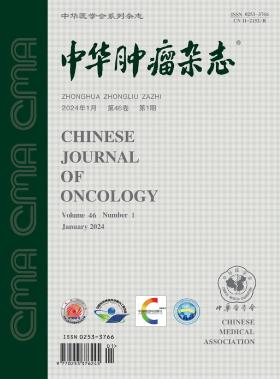[正常线粒体移植对三阴性乳腺癌细胞增殖、凋亡和干性的影响]。
摘要
研究目的观察正常细胞和三阴性乳腺癌细胞的线粒体形态,从正常细胞中提取线粒体,研究线粒体移植对三阴性乳腺癌细胞增殖、凋亡和干性的影响。研究方法用透射电子显微镜观察线粒体的形态。线粒体提取试剂盒提取线粒体,Western 印迹鉴定线粒体蛋白,线粒体膜电位检测试剂盒检测线粒体活性。用 MitoTracker Green 或 MitoTracker Deep Red 荧光探针标记活细胞的线粒体,并在 12、24 和 96 小时时用激光共聚焦显微镜观察线粒体进入 LTT 细胞的程度。线粒体移植 24 小时后,用 CCK8、集落形成试验、流式细胞术和球形成试验检测线粒体移植对乳腺癌细胞增殖、凋亡和干性的影响。结果显示正常细胞的线粒体呈杆状或拉长状,而三阴性乳腺癌细胞的线粒体呈肿胀和空泡状。Western 印迹结果显示,分离出的线粒体中存在由线粒体编码的细胞色素 c 氧化酶亚单位 I 蛋白(MT-CO1)。线粒体中热休克蛋白 60(HSP60)的含量高于细胞质。多模式微孔板阅读器结果显示,线粒体 J-聚集体/单体的含量为 1.67±0.06,显著高于对照组的 0.35±0.04(P<0.001)。线粒体移植后 12、24 和 96 小时,在 LTT 细胞中观察到外源性线粒体。CCK8 实验结果显示,移植 48 小时后,LTT 细胞的 OD450 为 0.27±0.13,低于对照组的 0.62±0.36(P=0.023)。MDA-MB-468 细胞的 OD450 为 0.30±0.03,低于对照组的 0.65±0.10(P=0.004)。线粒体移植 120 小时后,两组的 OD450 仍明显低于对照组(P<0.01)。线粒体移植 LTT 细胞形成的克隆数为 21.33±7.31,低于对照组的 35.22±13.59(P=0.016)。流式细胞术显示,线粒体移植 24 小时后,LTT 细胞的早期凋亡率为(30.07±2.15)%,高于对照组的(2.07±1.58)%(P<0.001)。MDA-MB-468细胞早期凋亡比例为24.47%±5.22%,高于对照组的(7.83±2.06)%(P=0.007)。此外,LTT细胞移植到细胞球中的线粒体数量为(46.25±5.40)个,明显低于对照组的(62.58±6.43)个(P<0.001)。结论正常线粒体可通过共培养进入三阴性乳腺癌细胞,抑制三阴性乳腺癌细胞的增殖和干性,促进三阴性乳腺癌细胞的凋亡。Objectives: To observe the mitochondrial morphology of normal and triple-negative breast cancer cells, extract mitochondria from normal cells, and investigate the effects of mitochondrial transplantation on proliferation, apoptosis, and stemness of triple-negative breast cancer cells. Methods: The morphology of mitochondria was observed by transmission electron microscope. Mitochondria were extracted by mitochondrial extraction kit, mitochondrial protein was identified by western blot, and mitochondrial activity was detected by mitochondrial membrane potential detection kit. MitoTracker Green or MitoTracker Deep Red fluorescent probes were used to label the mitochondria of living cells, and the degree of mitochondria entering LTT cells was observed by confocal laser microscopy at 12, 24, and 96 hours. The effects of mitochondrial transplantation on proliferation, apoptosis, and stemness of breast cancer cells were examined by CCK8, colony formation assay, flow cytometry, and sphere formation assay after 24 hours of mitochondrial transplantation. Results: The mitochondria of normal cells were rod-shaped or elongated, while the mitochondria of triple-negative breast cancer cells were swollen and vacuolated. Western blot results showed that cytochrome c oxidase subunit I (MT-CO1) protein encoded by mitochondria was present in the isolated mitochondria. The content of heat shock protein 60 (HSP60) was higher in mitochondria than that in cytoplasm. The result of the multi-mode microplate reader showed that the content of mitochondrial J-aggregates/monomer was 1.67±0.06, which was significantly higher than 0.35±0.04 of the control group (P<0.001). Exogenous mitochondria were observed in LTT cells at 12, 24, and 96 hours after mitochondrial transplantation. The results of the CCK8 experiment showed that OD450 of LTT cells was 0.27±0.13 after 48 hours transplantation, which was lower than 0.62±0.36 of the control group (P=0.023). The OD450 of MDA-MB-468 cells was 0.30±0.03, which was lower than 0.65±0.10 of the control group (P=0.004). After 120 hours of mitochondrial transplantation, OD450 in both groups was still significantly lower than that in the control group (P<0.01). The number of clones formed by mitochondrial transplantation of LTT cells was 21.33±7.31, which was lower than 35.22±13.59 of the control group (P=0.016). Flow cytometry showed that the early apoptosis rate of LTT cells was (30.07±2.15)% after 24 hours of mitochondrial transplantation, which was higher than 2.07±1.58 of the control group (P<0.001). The proportion of early apoptosis in MDA-MB-468 cells was 24.47%±5.22%, which was higher than (7.83±2.06)% in the control group (P=0.007). In addition, the number of mitochondria transplanted LTT cells into the cell sphere was 46.25±5.40, which was significantly lower than 62.58±6.43 of the control group (P<0.001). Conclusion: Normal mitochondria can enter triple-negative breast cancer cells by co-culture, inhibit the proliferation and stemness of triple-negative breast cancer cells, and promote the apoptosis of triple-negative breast cancer cells.

 求助内容:
求助内容: 应助结果提醒方式:
应助结果提醒方式:


